I wandered lonely as a cloud
That floats on high o’er vales and hills,
When all at once I saw a crowd,
A host, of golden daffodils;
Beside the lake, beneath the trees,
Fluttering and dancing in the breeze.Continuous as the stars that shine
And twinkle on the milky way,
They stretched in never-ending line
Along the margin of a bay:
Ten thousand saw I at a glance,
Tossing their heads in sprightly dance.The waves beside them danced, but they
Out-did the sparkling leaves in glee;
A poet could not be but gay,
In such a jocund company!
I gazed—and gazed—but little thought
What wealth the show to me had brought:For oft, when on my couch I lie
In vacant or in pensive mood,
They flash upon that inward eye
Which is the bliss of solitude;
And then my heart with pleasure fills,
And dances with the daffodils. ( William Wordsworth )
John Constable (1776-1837), one of the greatest English landscape painters, represented the naturalistic aspect of romanticism. His calm, deeply poetic response to nature approximated in painting the insights of William Wordsworth in poetry.John Constable sought to paint the skies and trees and, most of all, the light of England; an idea that shocked the art establishment of his time…
“In his own day, Constable’s point of view, and his methods of realizing it in paint, were quite new, and his art, therefore, was only appreciated by the few. The old traditions as to what should go to the making of a fine picture were still the sheet-anchors of the critics, and governed most of the popular landscape painting of the period. His earlier efforts, modest, quiet, and aiming only at a simple realism, passed unnoticed on the exhibition walls; and when, later on, his powers developed, and his portrayal of nature grew more vigorous and vivid, his pictures were subjected to much abuse and scornful criticism.”
In “Dedham Vale” ( 1802 ) John Constable looks through Gainsborough to the old seventeenth-century masters of landscape. The painting is also evidence that Constable had formed an influential new friendship, for its composition is remarkably like that of an exquisite seventeenth-century work by Claude Lorraine entitled “Hagar and the Angel”.
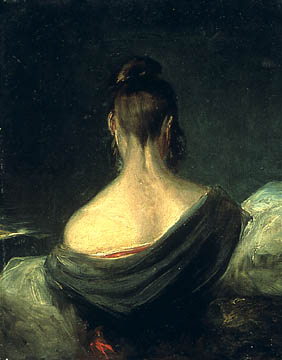
John Constable, Tête de jeune fille vue de dos, 1806 huile sur toile 25×20,3 collection particulière
Sir George Beaumont owned this painting and was so fond of it that he had it hung in his carriage when he traveled. His mother lived in Dedham, and it was inevitable that the man who was about to be the greatest patron of the Romantic movement and the man who was to be its leading painter should meet. It was an important friendship , for Sir George, whose collection would be the nucleus of the National Gallery he helped found, introduced Constable to the Rubens landscape called “Chateau de Steen”, to the paintings of other French masters, and to the works of such “modern” artists as Thomas Girtin. When Sir George asked one day whose style he would choose for his own, Girtin’s or the old masters’, Constable replied that it would be neither. His, he said, would be “God Almighty’s style.”
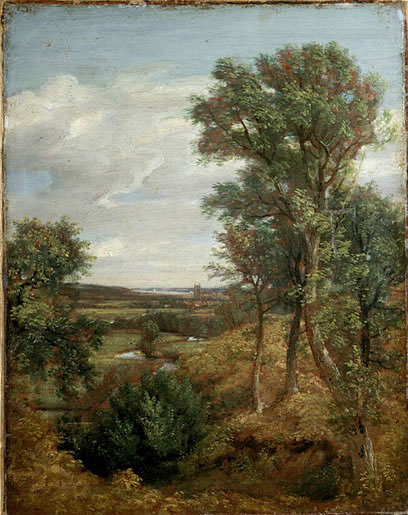
"John Constab
RA) 'Dedham Vale' Great Britain 1802 Oil on canvas Museum no. 124-1888 Given by Isabel Constable, daughter of the artist Constable based this study on the work of another artist. He rarely did this. However, here he used 'Hagar and the Angel', which the French artist Claude Lorrain painted in 1646. Constable esteemed Claude as 'the most perfect landscape painter the world ever saw'.
Dr. Johnson once said, “We all know what light is, but it is not easy to ‘tell’ what it is.”Dissatisfied with that kind of vagueness about something so vital to humanity, Constable set out to paint light. He saw that when the light changed, a place changed. It seems pretty obvious that a place could be many places, in the same way an individual would be constantly reinvented into new identities, but this was nonetheless Constable’s earliest and most important discovery. “The world is wide,” he said, “no two days are alike, not even two hours, neither were there ever two leaves of a tree alike since the creation of the world, and the genuine productions of art, like those of nature, are all distinct from each other. ”
He worked hard now, both to discover himself and to establish himself. He sent pictures to the Royal Academy, he copied family portraits for aristocrats, he then traveled about England to paint, as landscape artists were expected to do. In the Lake District Constable met William Wordsworth and, although they were never to become friends, he found in Wordworth’s poetry a perfect statement of the “natural” values he sought for his own art.
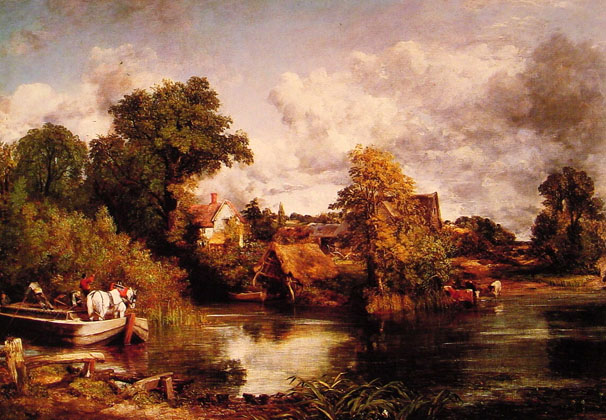
"Although he had scraped an income from painting, it was not until 1819 that Constable sold his first important canvas, The White Horse, which led to a series of "six footers", as he called his large-scale paintings."
His search would, of course, be successful. As one critic remarked, ” Few painter,s had Constable’s power to bring the infinite facts of nature into one single idea, and, with almost unconscious naturalness, to translate them into a poetic image.” Wordsworth and Constable, though they had little to do with each other, were the channels through which the English Romantic movement was to express itself in its most profound terms.
But it was a lonely course Constable had set for himself. “I see him silhouetted,” wrote Charles Leslie, his friend and first biographer, “coming from nowhere, going nowhere, but producing work of wonderful quality within lines sharply distinct from the ambiance of history.” There have been artists and writers who have prided themselves on “being distinct from the ambiance of history,” but Constable was not one of them. From the very beginning he worked to be understood and accepted.

Flarford MILL. "John Constable can be 'difficult' because, although he is now acknowledged as one of the all time great landscape painters, he is sometimes described as 'too chocolate boxy'. I think he was a great painter. Look at the way he achieves depth and distance in the middle distance on the right of the picture. With a small amount of space he has managed, by the use of sunlight on the grass and careful scaling, to give a real feeling of distance from those trees to the foreground. He was always extremely jealous of his contemporary, JMW Turner, who, if you read this blog regularly, you will know I rate as a real genius. But let's not get distracted John Constable is well-worthy of recognition. There was a time when landscape painting was seen as the lowest grade of art. Religious art and history painting were the highest regarded styles. If you consider a painting like Leonardo's Mona Lisa, the landscape, although finely painted, is very much background. Constable and Turner helped turn that attitude around."
In 1810 Constable came of age as a revolutionary artist. He had been struggling since about 1806 to free himself from the rules governing traditional landscape painting. Fortunately for art, Constable,s new “realism” was brilliantly suffused by his romantic imagination, and his work, with its broad sweeps of color and movement, reveals a man who saw poetry lying at the root of the everyday things in life.He had emerged, too, as an artist who had a keen double vision of what was happening around him. One part of him saw what most people saw when they set off to labor in the fields or factories along the river Stour; the other part of him invested these humble sights with a profound spiritual significance. It was a way of looking at life that Wordsworth described as “far more deeply informed.” Constable himself was fond of quoting a couplet by the Suffolk poet George Crabbe:
“It is the soul that sees; the outward eyes/ Present the subject, but the mind descries.”
Constable’s “outward eyes” were those of a gentleman farmer, a corn merchant, and, since the sea was so near, a sailor. They were also the eyes of a naturalist and meteorologist. He was a dreamer who constantly demanded hard facts. He crowded his sketchbooks with the facts; carts, plows, sailing tackle, notes about the weather, and then, in his paintings, made them all subservient to “nature” , the wonderful and mysterious force that controlled everything.

A detail from Constable's 'Cornfield' (1826), with a church tower near the horizon Photo: National Gallery/The Bridgeman Art Library
He was fascinated by time. When work on a picture continued long past the hour of the day to which it belonged, he would go to great trouble to get every detail correct. “The Cornfield” ( 1826) is a view of the Stour Valley on a hot July day, but it was later in the year when Constable began to work on the foreground, and this involved receiving advice from a botanist, Mr. Phillips, in order to capture all the details.
Constable”s religious attitude toward landscape , his “inner eye” was obvious even has his career began. Sometimes it overwhelmed him and made him doubt everything he was trying to do:” Nothing can exceed the beauty of the country,” he wrote, “it makes pictures seem sad trumpery, even those that possess most of nature.” When he saw the kind of landscape that was popular at the Royal Academy he saw blasphemy. “Good God!- what a sad thing it is that this lovely art is so wrested to its own destruction-only used to blind our eyes and senses from seeing the sun shine, the fields bloom, the trees blossom, and to hear the foliage rustle- the old black, rubbed-out, dirty bits of canvas to take the place of God’s own works.”
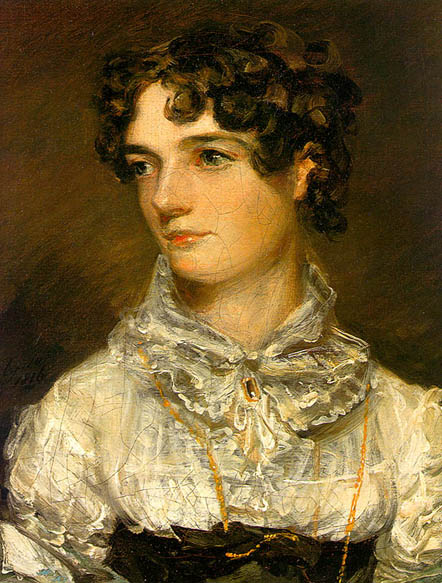
"Maria Bicknell was a daughter of the Solicitor to the Admiralty. Her grandfather was the rector of East Bergholt, where Constable first met her in 1800. The two fell in love in 1809 but, partly because of the Rector's opposition, did not marry until 1816. Constable painted Maria's portrait in July 1816, about three months before their marriage. In August Constable wrote to Maria from Suffolk: 'I would not be without your portrait for the world the sight of it soon calms my spirit under all trouble'. Twelve years later Maria died from tuberculosis, leaving seven young children to Constable's care. Maria's father, Charles Bicknell, a solicitor, was reluctant to see Maria throw away this inheritance, and Maria herself pointed out that a penniless marriage would detract from any chances John had of making a career in painting. Golding and Ann Constable, while approving the match, held out no prospect of supporting the marriage until Constable was financially secure; but they died in quick succession, and Constable inherited a fifth share in the family business."
“In reading Leslie’s ” Life” of the artist one is struck by his constant protest against tradition. He never hesitated to express, and with the ut-most vigour, his scorn for the connoisseur of his day, who only admired a picture when it was buried under a coat of dirty varnish, and built up on certain formulae, against which it was high treason to protest. He had, on the other hand, the deepest admiration for all that was finest in the painting of the old masters, and a thorough knowledge of the work of earlier painters of many schools. In his younger days he spent much time in copying their pictures, a practice he carried on from time to time throughout life. He took a particular delight in Claude, and copied his landscapes with great skill whenever he got the opportunity. Ruysdael, Hobbema, and Rubens, among others, he studied in a similar way. In his letters he frequently writes with the greatest delight and appreciation of such painters as De Hoogh, Watteau, Gainsborough, and Turner, while his praise of the younger Cozens was extravagant. His own art, too, was influenced by his close study of the earlier men, and his system of chiaroscuro, in particular, was based upon their methods. In this way his art is connected with the masters who had preceded him, though he developed it upon lines which were essentially new ones, owing nothing except to his own genius.”
The art world Constable set out to enter-rather than conquer-was dominated by members of the Royal Academy, most of them portrait painters and what were called “history” painters.The acknowledged leader of the portrait painters was Sir Thomas Lawrence, who captured the elegance of Regency England and gave his sitters t he heroic attitudes that the long years of war against Napoleon had made popular. History painters turned out stories, morals and anecdotes. Battles, national events, idealized cottage scenes, episodes from the Bible, Shakespeare, or the classical poets; these were the subjects people liked to have hanging on their walls.
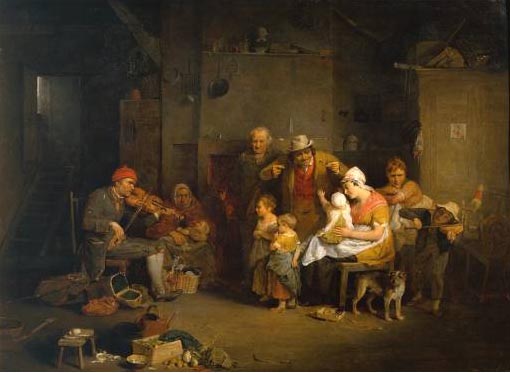
The Blind Fiddler by Sir David Wilkie (1785-1841). 1806. Oil on mahogany support, 578 x 794 mm frame: 1065 x 1270 x 200 mm painting. Presented by Sir George Beaumont, 1826. Tate Gallery, London (N00099) According to the Tate chat label, "Soon after the founding of the Royal Academy, Joshua Reynolds admitted he was worried that its annual exhibitions would tempt artists to abandon classical subjects and idealism in favour of pictures showing common life in particularised detail. He described such "genre painters" as artists who "express with precision the various shades of passion as they are exhibited by vulgar minds." But not long after Reynolds' death, the work of a young genre painter named David Wilkie was received ecstatically at Royal Academy exhibitions. This painting, shown at the RA in 1807, is the antithesis of Reynolds's "great style."
The Royal Academy, which had been in existence for nearly forty years, set the standards for what was acceptable as art, serving a clientele drawn mainly from the middle class. Constable and the Academy, and its customers, were at odds from the very start.He flatly refused to be what he called “a ladies’ and gentleman’s painter,” and Academy clients objected to what they called his “low” art. His brushwork offended them, and they could not understand why anyone would want pictures of ordinary bards, mills and laborers.
They wanted theatrical pieces like ” Belshazzar’s Feast” by John Martin, which resembled a glittering scene from one of Handel’s operas. “The Blind Fiddler”, by David Wilkie, allowed them to indulge their Christian compassion for the poor,and they enjoyed huge, action-filled canvases like Benjamin West’s “Battle of La Hague”. The public’s eagerness for glossy miracles of technique and pictorial novelty shocked Constable:
“In such an age as this, painting should be understood, not looked on with blind wonder, nor considered as a poetic aspiration, but as a pursuit, legitimate, scientific and mechanical.” (Quoted in Constable by John Sunderland P15-16)


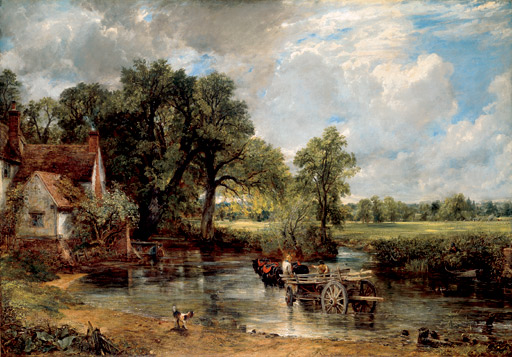


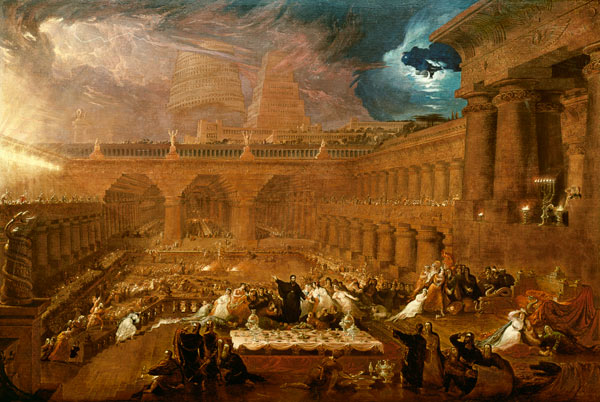
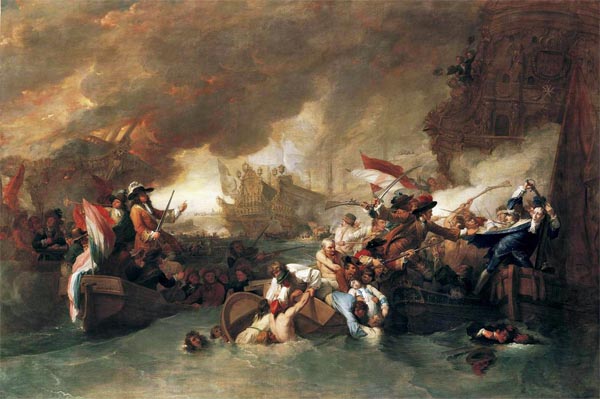




 COMMENTS
COMMENTS



